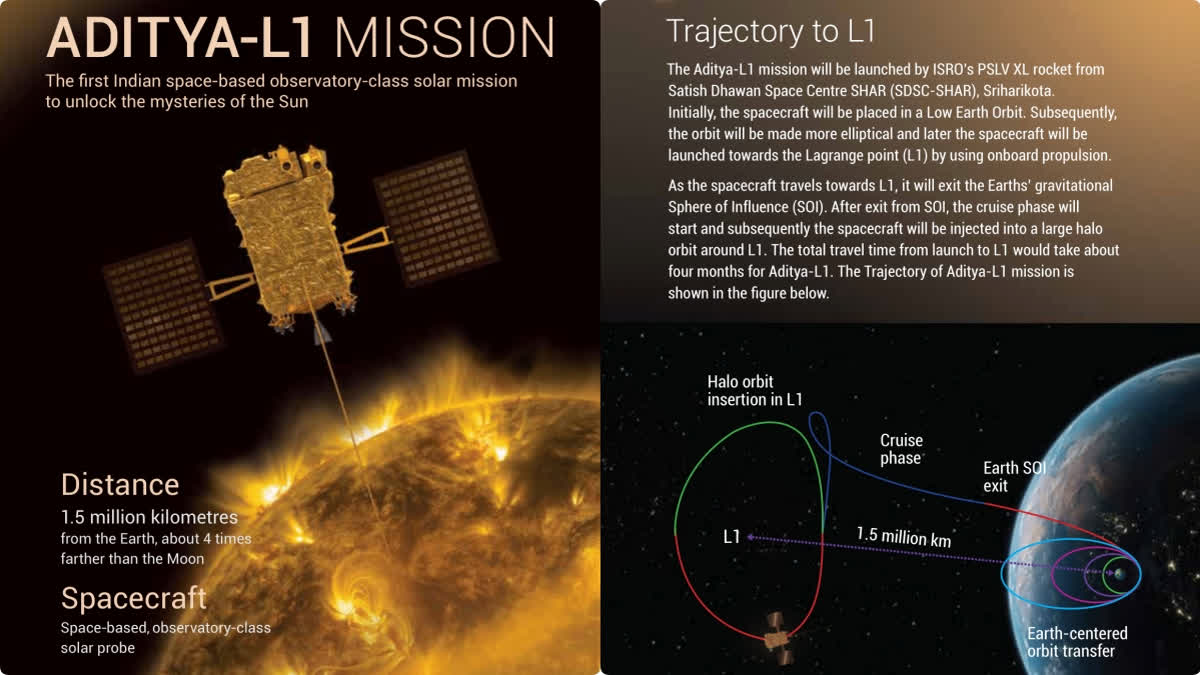Bengaluru: India's first space-based observatory to study the Sun, Aditya-L1, will be launched on September 2 at 11.50 am from Sriharikota, the Indian Space Research Organisation (ISRO) announced on Monday. The mission will cover 1.5 million kilometres from the Earth, about four times farther than the Moon.
ISRO invited the citizens to witness the launch from the Launch View Gallery at Sriharikota by registering on a weblink it shared on its official X (formerly Twitter) handle.
-
🚀PSLV-C57/🛰️Aditya-L1 Mission:
— ISRO (@isro) August 28, 2023 " class="align-text-top noRightClick twitterSection" data="
The launch of Aditya-L1,
the first space-based Indian observatory to study the Sun ☀️, is scheduled for
🗓️September 2, 2023, at
🕛11:50 Hrs. IST from Sriharikota.
Citizens are invited to witness the launch from the Launch View Gallery at… pic.twitter.com/bjhM5mZNrx
">🚀PSLV-C57/🛰️Aditya-L1 Mission:
— ISRO (@isro) August 28, 2023
The launch of Aditya-L1,
the first space-based Indian observatory to study the Sun ☀️, is scheduled for
🗓️September 2, 2023, at
🕛11:50 Hrs. IST from Sriharikota.
Citizens are invited to witness the launch from the Launch View Gallery at… pic.twitter.com/bjhM5mZNrx🚀PSLV-C57/🛰️Aditya-L1 Mission:
— ISRO (@isro) August 28, 2023
The launch of Aditya-L1,
the first space-based Indian observatory to study the Sun ☀️, is scheduled for
🗓️September 2, 2023, at
🕛11:50 Hrs. IST from Sriharikota.
Citizens are invited to witness the launch from the Launch View Gallery at… pic.twitter.com/bjhM5mZNrx
The Aditya-L1 mission will be launched by ISRO's PSLV XL Satish Dhawan Space Centre SHAR (SDSC-SHAR), Sriharikota. Initially, the spacecraft will be placed in a Low Earth Orbit. Subsequently, the orbit will be made more elliptical and later the spacecraft will be launched towards the Lagrange point (L1) by using onboard propulsion.
As the spacecraft travels towards L1, it will exit the Earths’ gravitational Sphere of Influence (SOI). After exit from SOI, the cruise phase will start and subsequently the spacecraft will be injected into a large halo orbit around L1. The total travel time from launch to L1 would take about four months for Aditya-L1.
Major Science Objectives:
- Coronal heating and solar wind acceleration
- Coupling and dynamics of the solar atmosphere
- Solar wind distribution and temperature anisotropy
- Initiation of Coronal Mass Ejection (CME), flares, and near-earth space weather
Uniqueness of Aditya-L1
- First-time spatially resolved solar disk in the near UV band
- CME dynamics close to the solar disk (~from 1.05 solar radius) thereby providing information in the acceleration regime of CME, which is not observed consistently
- Onboard intelligence to detect CMEs and solar flares for optimised observations and data volume
- Directional and energy anisotropy of solar wind using To multi-direction observations
Aditya L1 shall be the first space based Indian mission to study the Sun. The spacecraft shall be placed in a halo orbit around the Lagrange point 1 (L1) of the Sun-Earth system, which is about 1.5 million km from the Earth. A satellite placed in the halo orbit around the L1 point has the major advantage of continuously viewing the Sun without any occultation/eclipses. This will provide a greater advantage of observing the solar activities and its effect on space weather in real time.
The spacecraft carries seven payloads to observe the photosphere, chromosphere and the outermost layers of the Sun (the corona) using electromagnetic and particle and magnetic field detectors. Using the special vantage point L1, four payloads directly view the Sun and the remaining three payloads carry out in-situ studies of particles and fields at the Lagrange point L1, thus providing important scientific studies of the propagatory effect of solar dynamics in the interplanetary medium.
Also read: After conquering Moon, ISRO eyes Sun; launch of Aditya-L1 solar mission set for Sept 2
Also read: ISRO gearing up for mission to study Sun, satellite arrives at Sriharikota for launch



